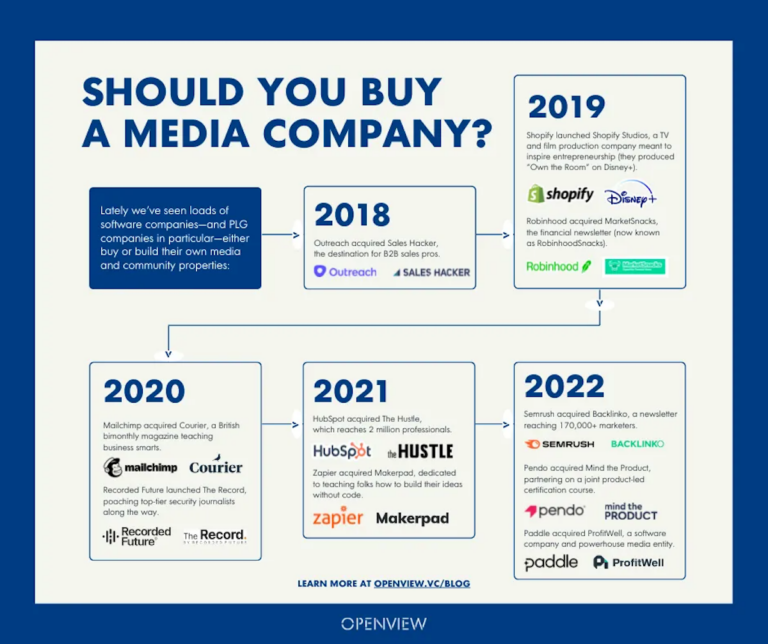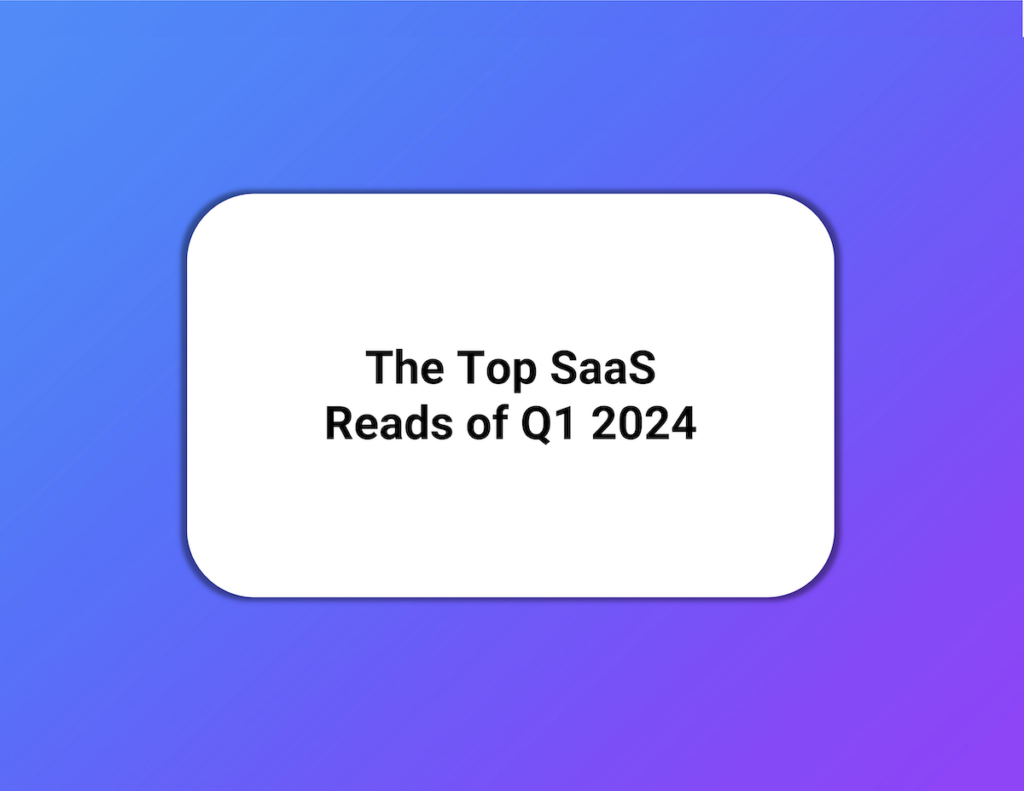Over the past few years, 20+ SaaS companies either launched or acquired a media arm, placing media-like content at the center of their growth strategy.
- HubSpot acquired The Hustle
- Pendo acquired Mind the Product
- Salesforce launched Salesforce+
- Crossbeam launched Insider
In today’s noisy landscape, where it’s harder to stand out and easier to be forgotten, more SaaS companies are embedding a media business inside them. Here’s why.
The war for attention
Attention is all you need, but it’s becoming harder to get
There’s so much content out there. As companies battle for attention, customer channels are becoming increasingly more crowded. And this activity can leave your brand buried under all that noise.
You don’t own where you publish
What’s worse is that you don’t own the platforms you publish on. Like most SaaS companies, social and search are two primary distribution channels. But BigTech owns these platforms – they control what content is surfaced and to whom.
A single update to their algorithm can disrupt your entire distribution strategy. One day you’re ranking high and gaining impressions, and the next day you aren’t.
Is media the new marketing?
The content landscape is shifting. Audiences today are seeking more “intimate” ways to consume information. Creator-led content, video series, and podcasts are now favored over white papers and generic blogs.
As a result, SaaS companies are turning to the media industry for inspiration. We’re seeing more corporations merge traditional media with marketing, operating in-house publishing arms, and creating journalistic and consumer-like content.
Let’s dive into the strategy!
Why traditional media wins over attention
Throughout this article, I use the term “media” to describe content providers that either inform, educate, or entertain an audience. These providers are in the business of content creation and distribution.
Traditional media excels at capturing attention for two reasons:
- Content is the core product
- They distribute on platforms they own
In the business of content
For traditional media, content is the core product. You land on a news article or report, you consume the content, and you receive the promised value. Whether it’s staying informed on the latest topics, trends, or research, the content is the destination.
But for SaaS companies, content feels more like a byproduct. You land on the blog, you consume the content, but the value is promised within the software (or blocked by sales). While some blogs vary in depth and coverage, they all aim to drive conversions.
Comparing media and SaaS content
The distinction between media and SaaS content can be summarized into two groups.
- Content that serves the reader
- Content that services the funnel
While SaaS companies also create content that serves the reader, blogs are heavily skewed toward servicing the funnel. The goal is to click and convert, compared to media, where you click and consume.
However, over the past few years, we’re starting to see companies adopt a more media-like strategy for their content. And this adoption comes in various models.
The convergence of media and marketing

The four models of media
In 2015, HubSpot published The CMO’s Guide to Brand Journalism, a perspective piece describing the convergence of media and marketing as more brands launch publishing operations. This deep dive was written by Dan Lyons, a former editor at Newsweek, and drills into how companies can create more “journalistic” content and why they should.
Dan describes four ways to create media inside a corporation. The first two models lean toward traditional media while the last two align with the SaaS blogs we see today.
Here’s my slightly adapted version of Dan’s model.
Industry News:
- You report on industry news, creating coverage that supplements the work of mainstream media.
- You’re not solely focused on driving clicks, but instead providing behind-the-scenes context that media won’t or can’t cover.
- Examples: Intel (Intel Free Press) and Microsoft (News).
Research & Content Series [Brand Awareness]:
- You publish stories, research papers, and content series to drive awareness of your brand.
- You’re not trying to generate sales directly from those articles, but instead, you position your brand as a knowledge bank.
- Examples: PitchBook (News & Analysis) and Salesforce (Salesforce+).
Independent Content-hubs [Create and Sponsor]:
- Through an independent site, you curate/ create content that serves a specific audience to establish yourself as a thought leader.
- While the site is sponsored by your company, the goal is to provide a go-to source where your audience can stay up-to-date with an industry or topic.
- Example: Adobe (CMO.com) [As of 2019, Adobe moved CMO.com under its blog].
Corporate Blogs [Lead Generation]:
- You publish a high volume of blogs spanning a wide range of topics, each relating to your product.
- Your content is designed to service the sales funnel: blogs are optimized for search and the goal is to click and convert.
- Examples: HubSpot and Zapier.
A multi-media approach
These four models only scratch the surface of media that’s created today. Brands are now taking a multi-media approach, writing informational newsletters, creating communities, and launching their own “Netflix-like” series.
But before you set out to launch a media operation, there’s another approach that’s becoming more popular. You don’t have to build a media brand – you can buy them too.
Why SaaS companies are buying media brands
Over the past few years, a growing number of SaaS companies have been acquiring media-first businesses. According to Kyle Poyar, there are a few reasons why this strategy works.

(Image created by Kyle Poyar at Growth Unhinged)
High-reach, low-cost brand awareness
Attracting an audience for low-cost
Traditional media excels at attracting and engaging large audiences at a relatively low cost. By owning a media arm, SaaS companies bypass the high costs of direct marketing, placing their brands directly in the mix of where potential users already spend their time.
Amplifying a company’s growth motion
Owning a media arm accelerates a bottoms-up growth motion. This strategy embeds the brand into the user’s daily content consumption habits.
A product is presented in a context that feels less like a pitch and more like valuable content. This method fosters trust and facilitates the user journey from awareness to adoption.
Building engaged communities
Acquiring or developing media outlets helps create engaged, self-sustaining communities. These communities are not just support forums; but channels to facilitate user-generated content. This method creates a growth loop that attracts new users through organic, word-of-mouth promotion.
Whether you buy or build a media arm, the benefits are the same: seamlessly creating brand awareness where your audience consumes your content. To help make these benefits more concrete, we’ll walk through a few examples.
SaaS companies with media brands
HubSpot acquired the Hustle
- Description: a daily newsletter covering business and tech topics
- Acquisition date: February 2021
- Audience size: 1.5 million subscribers
- Audience persona: business professionals, entrepreneurs, marketers
- Media type: Daily Newsletter (paid subscription, trends).
Pendo acquired Mind the Product
- Description: a product management community that provides content, training, and conferences
- Acquisition date: February 2022
Audience size: 300,000 members - Audience persona: product managers, designers, and developers
- Media type: Community (user-generated content, video, conferences)
Salesforce launched Salesforce+
- Description: a streaming service that offers live and on-demand content covering a variety of topics including business, innovation, and career
- Launch date: August 2021
- Audience size: 60,000 viewers
- Audience persona: Business professionals
- Media type: Video
Crossbeam launched Insider
- Description: a content hub for ecosystem-led growth insights offering playbooks, success stories, and industry data in easy-to-browse collections.
- Launch date: July 2023
- Audience size: 50,000+
- Audience persona: B2B GTM professionals
- Media type: Long-form content (videos)
20+ examples of SaaS media brands
(James Carbary helped source the companies in this table)
What's next?
Let’s do a quick recap.:
- Media companies win over attention for two reasons: 1) content is their core product and 2) they own their distribution
- By having content be their core focus, media companies create to serve the reader, instead of just servicing the funnel
- By owning a media arm, SaaS companies can seamlessly create brand awareness where their audience consumes content, and do so at a relatively low cost
In my next post, I’ll write about how to build a media operation. Stay tuned!
Looking for more SaaS Weekly stories?
Stay up-to-date with the latest growth stories and curated SaaS content by subscribing to SaaS Weekly. Every Friday, we send you the best articles and case studies to inform your next growth strategy.

The Top SaaS Reads of Q1 2024
Dive into the top SaaS reads of Q1 2024. Discover what articles were clicked-on the most across the weekly roundups.

Are SaaS companies becoming media businesses?
In today’s noisy landscape, we’re seeing more SaaS companies embedding a media business inside them. Here’s why.

Your Guide to Better B2B SaaS Email Nurture Campaigns
Discover the power of email nurture campaigns in B2B SaaS to drive growth. Our comprehensive guide highlights how consistent, value-driven emails can nurture interest into intent.







